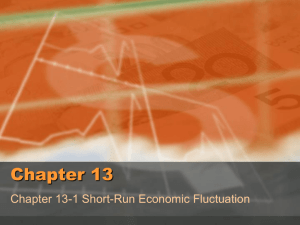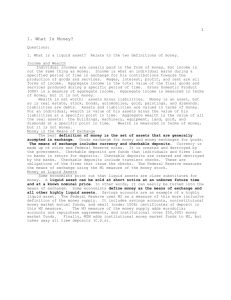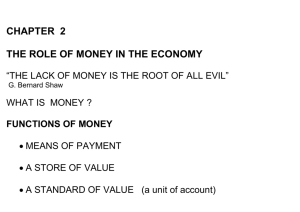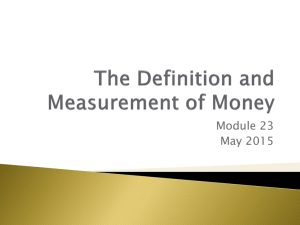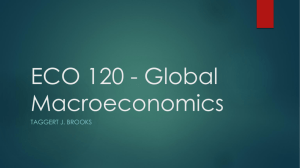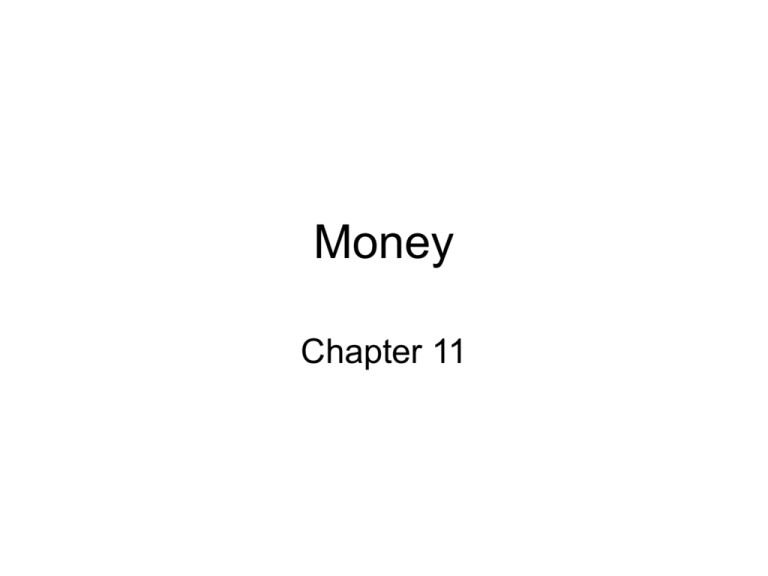
Money
Chapter 11
Today’s lecture will:
• Discuss why the financial sector is central
to almost all macroeconomic debates.
• Explain what money is.
• Enumerate the three functions of money.
• State the alternative measures of money
and their components.
Today’s lecture will:
• Explain how banks create money.
• Calculate both the simple and the
approximate real world multiplier.
• Explain how a financial panic can occur
and the potential problem with government
guarantees to prevent such panics.
Why is the Financial Sector
Important to Macro?
• The financial sector channels savings back into the
circular flow.
• For every financial asset, there is a corresponding
financial liability.
– Financial assets – assets such as stocks or bonds,
whose benefit to the owner depend on the issuer of the
asset meeting certain obligations.
– Financial liabilities - obligations by the issuer of the
financial asset.
The Financial Sector as a Conduit
for Savings
Pension funds
CDs
Savings
deposits
Checkable
deposits
Stocks
Bonds
Government
Securities
Life insurance
Outflow
from
spending
stream
Inflow
from
spending
stream
Gov’t
Gov’t
House- Saving
holds
Corporations
Loans
Financial Sector
Households
Corporations
Large
business
loans
Small
business
loans
Venture
capital
loans
Construction
loans
Investment
loans
The Role of Interest Rates in the
Financial Sector
• Bonds are promises to pay a certain amount plus
interest in the future.
• The price of a bond is determined by the market
interest rate.
• The price of bonds varies inversely with the
interest rate.
Interest
Rates
Bond
Prices
Interest
Rates
Bond
Prices
Interest Rates and Inflation
Real interest rate = nominal interest rate –
expected inflation
• Nominal interest rate – the interest rate you
actually see and pay when borrowing or receive
when lending.
• Real interest rate – the nominal interest rate
adjusted for inflation.
• If inflation occurs, the value of money decreases,
so lenders charge a higher interest rate to
compensate for the loss of purchasing power.
Functions of Money
• Money is a medium of exchange.
• Money is a unit of account.
• Money is a store of wealth.
Money As a Medium of
Exchange
• Money facilitates exchange by reducing
the cost of trading.
• Without money, we would have to barter.
• Barter – a direct exchange of goods and
services.
Money As a Medium of
Exchange
• Money does not have to have any inherent
value to function as a medium of
exchange.
• All that is necessary is that everyone
believes that other people will exchange it
for their goods.
Money As a Unit of Account
• Money prices are actually relative prices.
• A single unit of account saves our limited
memories and helps us make reasonable
decisions based on relative costs.
Money As a Unit of Account
• Money is a useful unit of account only as
long as its value relative to other prices
does not change too quickly.
Money as a Store of Value
• Money is a financial asset.
• As long as money is serving as a medium
of exchange, it automatically also serves
as a store of wealth.
Money as a Store of Value
• Money’s usefulness as a store of wealth
also depends upon how well it maintains
its value.
• Hyperinflations destroy money’s
usefulness as a store of value.
Alternative Measures of Money
• A number of different financial assets
serve some functions of money and thus
have a claim to being called money.
• They are called M1, M2, and L.
Alternative Measures of Money:
M1
• M1 consists of currency in the hands of
the public, checking account balances,
and travelers’ checks.
• Checking account deposits are included in
all definitions of money.
Alternative Measures of Money
• M1 – currency in the hands of the public,
checking account balances, and travelers’
checks.
• M2 – M1 plus other relatively liquid assets,
such as savings deposits, smalldenomination time deposits (CDs), and
money market mutual fund shares.
• L – almost all short-term liquid financial
assets.
Beyond M2:
• It has become difficult to define money in
an ever-changing world.
• Broader concepts of asset liquidity have
taken the place of measures of money.
Components of M2 and M1
Components of M1
Savings
deposits
(48%)
Components of M2
Money market
mutual funds (16%)
Currency (50%)
M1(28%)
(21%)
M1
Small-denomination
time deposits (15%)
Traveler’s checks (1%)
McGraw-Hill/Irwin
Checking
accounts (49%)
© 2004 The McGraw-Hill Companies, Inc., All Rights Reserved.
Distinguishing Between Money
and Credit
• Credit card balances cannot be money
since they are assets of a bank.
• In a sense, they are the opposite of
money.
Distinguishing Between Money
and Credit
• Credit cards are prearranged loans.
• Credit cards affect the amount of money
people hold.
• Generally, credit card holders carry less
cash.
The Definition and
Functions of Money
• Money is a highly liquid financial
asset.
– Liquid – easily changeable into another
good or asset.
• Money serves as:
– A medium of exchange.
– A unit of account.
– A store of wealth.
Money as a Medium of Exchange
• Money facilitates exchange by reducing the
cost of trading.
• Without money, we would have to barter.
• Money has no inherent value to function as
a medium of exchange.
• It acts as a medium of exchange because
people are willing to accept as payment for
goods and services.
Money as a Unit of Account
• Money is used as a common denominator to
measure the relative values of goods and services.
• Without money, we would have to measure the
value of goods and services in terms of other
goods and services.
• Money is a useful unit of account only if its value
relative to the average of all other prices doesn’t
change too quickly.
Money as a Store of Value
• Money is a financial asset that can be
used to store wealth (income that you
have saved and not consumed).
• As a store of wealth, money pays no
interest, but is perfectly liquid.
• Money’s usefulness as a store of wealth
depends on how will it maintains its
value.

